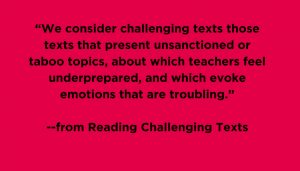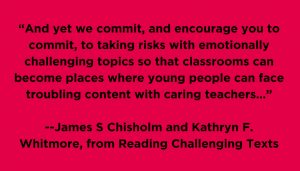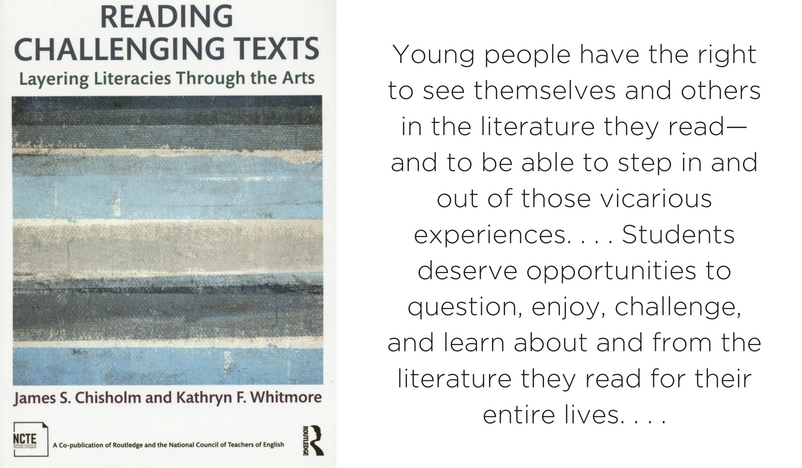What are your students reading? What texts form the basis of your students’ study in your classroom? Are you selecting challenging texts and helping students flesh out what they’re reading, even delving into the “forbidden topics” raised in the texts?

James S. Chisholm and Kathryn F. Whitmore, authors of a new NCTE book Reading Challenging Texts: Layering Literacies Through the Arts, point out that the more ways we look at literature, the more we involve ourselves in the literature, the more we learn about it, ourselves, and our community. They
recognize that to decide to read such literature with students is an act of professional courage. Every student has the right to read and the “freedom to explore ideas and pursue truth whenever and however they wish” (NCTE). Furthermore, young people have the right to see themselves and others in the literature they read—and to be able to step in and out of those vicarious experiences. And . . . students deserve opportunities to question, enjoy.
You know this, but what do you do about those in the community who might not be so keen on having their students read about what they consider to be “taboo topics”? The authors of Reading Challenging Texts note,
Some adults ascribe to and express a discourse of innocence, which references the desire that children and adolescents be kept from knowing about emotionally troubling content.
So how do we prepare for those adults? Make sure we start our year with their students with explanations of the importance of deep learning and how literacy learning works best for their learners. Then make sure to have solid rationales for our choices of texts in case we are challenged. Don’t be a renegade—protect yourself. Get buy-in from others as Jeff Kaplan describes in his blog.
Reading Challenging Texts uses The Diary of a Young Girl by Anne Frank as their exemplar text, yet Diary is on the ALA list of Frequently Challenged Young Adult books. Regarding that text, the authors point out,
Holocaust and Judaism in general, and death camps and other atrocities more specifically are forbidden topics for children and adolescents. At least four topics—death, genocide, religion, and sexuality—are implicit and often quite explicit elements of Diary about which teachers must make instructional decisions as they engage with students as they read. . . . Yet we argue . . . that we cannot protect ourselves from fear, guilt, or sadness that we experience about taboo topics and difficult knowledge by silencing students or censoring topics out of classrooms. Rather making space in school to sanction taboo topics, and the emotions that live alongside them, is a choice teachers must make. . . .
. . . . We want to recognize that to decide to read such literature with students is an act of professional courage. Every student has the right to read and the “freedom to explore ideas and pursue truth whenever and however they wish” (NCTE). Furthermore, young people have the right to see themselves and others in the literature they read—and to be able to step in and out of those vicarious experiences. And . . . students deserve opportunities to question, enjoy, challenge, and learn about and from the literature they read for their entire lives. . . . When students learn about and from challenging texts, they learn to read the word and the world.

Reading Challenging Texts focuses on how to bring into play the visual literacies (seeing the text), the embodied literacies (being the text), and the emotional literacies (feeling the text) while we’re teaching texts. It demonstrates how to “layer literacies through the arts” to deepen our students’ connections with the challenging texts we owe them.
This book will be the focus of this summer’s NCTE Reads which begins June 1.

